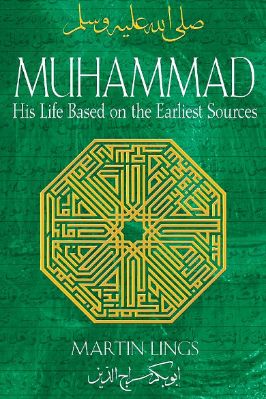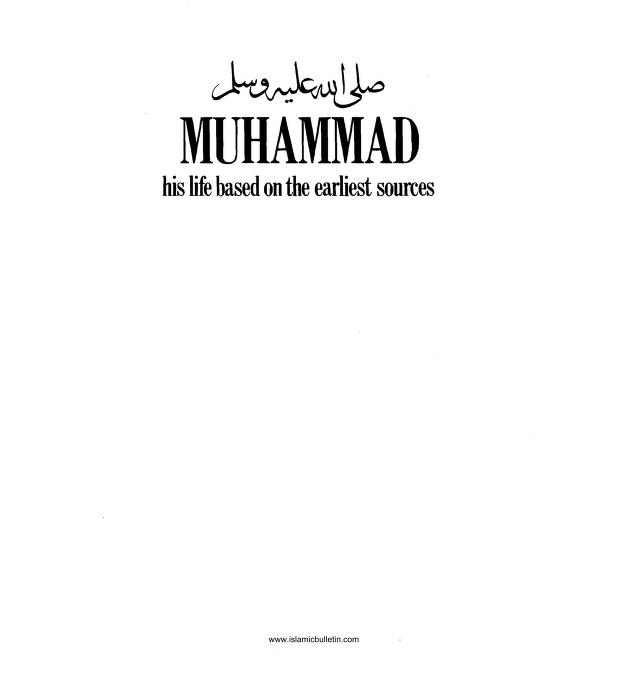
| Book Title | Muhammadhis Life Based On The Earliest Sources By Martin Lings |
| Book Author | Martin Lings |
| Total Pages | 362 |
| Book Views | |
| Language | English |
| Book Download | PDF Direct Download Link |
| Get Hardcover | Click for Hard Copy from Amazon |
Muhammad, his life based on the earliest sources by Martin Lings by Smirna Si
About the Book
“Muhammad: his life based on the earliest sources from all other serious Prophetic biographies. It it is fair to say Lings often has more imagination than knowledge of what he describes and never takes to heart the absolute prohibition of fiction in Islam with regard to the Prophet.
Consequently, his constant embroidery detracts from the reliability of his book and, much as it is meant to enhance reading, brings it down to the romance level from which its title-page homage to “the earliest sources” had promised to exempt it.
There are two or three more momentous misinterpretations in Muhammad: his life based on the earliest sources. He defended them in reprint after reprint by beefing up his footnotes with references he thought provided enough justification.
One of them is the “lightly clad” Zaynab scene – in his defense an error of taste that predates him; but an error, nevertheless, that “betokens ignorance of the immense rights and merits of the Prophet” according to Qadi Abu Muhammad al-Qushayri al-Maliki as cited by Qadi Iyad. Another such misinterpretation is the “Kaba icon” episode.
Muhammad: His Life Based on the Earliest Sources by Martin Lings
Book Contents
- The House of God
- A Great Loss
- Quraysh of the Hollow
- The Recovery of a Loss
- The Vow to Sacrifice a Son
- The Need for a Prophet
- The Year of the Elephant
- The Desert
- Two Bereavements
- Bahirà the Monk
- A Pact of Chivalry
- Questions of Marriage
- The Household
- The Rebuilding of the Ka’bah
- The First Revelations
- Worship
- “Warn Thy Family”
- Quraysh Take Action
- Aws and Khazraj
- Abu Jahl and Hamzah
- Quraysh Make Offers and Demands
- Leaders of Quraysh
- Wonderment and Hope
- Family Divisions
- The Hour
- Three Questions
- Abyssinia
- ‘Umar
- The Ban and its Annulment
- Paradise and Eternity
- The Year of Sadness
- “The Light of Thy Countenance”
- After the Year of Sadness
- Yathrib Responsive
- A Conspiracy
- Many Emigrations
- The Hijrah
- The Entry into Medina
- Harmony and Discord
- The New Household
- The Threshold of War
- The March to Badr
- The Battle of Badr
- The Return of the Vanquished
- XLV. The Captives
- XLVI. Bani Qaynuqa’
- XLVII. Deaths and Marriages
- XLVIII. The People of the Bench
- XLIX. Desultory Warfare
- L. Preparations for Battle
- LI. The March to Uhud
- LII. The Battle of Uhud
- LIII. Revenge
- LIV. The Burial of the Martyrs
- LV. After Uhud
- LVI. Victims of Revenge
- LVII. Bani Nadir
- LVIII. Peace and War
- LIX. The Trench
- LX. The Siege
- LXI. Bani Qurayzah
- LXII. After the Siege
- LXIII. The Hypocrites
- LXIV. The Necklace
- LXV. The Lie
- LXVI. The Dilemma of Quraysh
- LXVII. “A Clear Victory”
- LXVIII. After Hudaybiyah
- LXIX. Khaybar
- LXX. “Whom Lovest Thou Most?”
- LXXI. After Khaybar
- LXXII. The Lesser Pilgrimage and its Aftermath
- LXXIII. Deaths and the Promise of a Birth
- LXXIV. The Battle of Hunayn and the Siege of Ta’if
- LXXV. A Breach of the Armistice
- LXXVI. The Conquest of Mecca
- LXXVII. After the Victory
- LXXVIII. Tabük
- LXXIX. After Tabük
- LXXX. The Succession and the Burial
- LXXXI. The Degrees
- LXXXII. The Future
- LXXXIII. The Farewell Pilgrimage
- LXXXIV. The Choice
- LXXXV. The Farewell Pilgrimage
- Map of Arabia (by Steven W. Johnson)
- Quraysh of the Hollow (genealogical tree)
- Note on Pronunciation of Arabic Names
- Key to References
- Index
Expanded book Description
“Muhammad: His Life Based on the Earliest Sources” by Martin Lings is a comprehensive exploration of the life and journey of the Prophet Muhammad, peace be upon him. The book is meticulously organized, and its structure is derived from the table of contents, which provides a detailed overview of its contents.
The narrative begins with “The House of God,” shedding light on the significance of the Kaaba and its central role in Islamic worship. It then delves into the early life of the Prophet Muhammad, detailing “A Great Loss” and “Quraysh of the Hollow,” which lay the foundation for the challenges and triumphs that would follow.
As the narrative progresses, readers are introduced to the early years of the Prophet’s life, including “The Recovery of a Loss,” “The Vow to Sacrifice a Son,” and “The Need for a Prophet.” The book examines pivotal moments such as “The Year of the Elephant” and “The Desert,” providing a historical and cultural context.
The narrative continues with “Two Bereavements” and “Bahirà the Monk,” exploring the events that shaped the Prophet’s character and destiny. It then delves into the social and moral aspects of his life, touching on topics like “A Pact of Chivalry,” “Questions of Marriage,” and “The Household.”
Readers are guided through the spiritual journey of the Prophet Muhammad, with chapters like “The Rebuilding of the Ka’bah,” “The First Revelations,” and “Worship.” The book highlights the divine guidance that the Prophet received, as evident in “Warn Thy Family.”
The narrative takes a dramatic turn as it documents the reactions of the Quraysh, the leaders of Mecca, to the emerging faith in chapters like “Quraysh Take Action,” “Aws and Khazraj,” and “Abu Jahl and Hamzah.” It further explores the negotiation and confrontation between the Prophet and the Quraysh, as well as the offers and demands presented in “Quraysh Make Offers and Demands.”
Throughout the book, the reader is introduced to key figures and leaders within the Quraysh community, offering insight into the societal dynamics and conflicts of the time. These figures are discussed in the chapter “Leaders of Quraysh.”
The book narrates the sense of “Wonderment and Hope” that accompanied the burgeoning faith, and the resulting “Family Divisions.” It also introduces the concept of “The Hour” and poses “Three Questions” that weigh heavily on the hearts and minds of the people.
A significant portion of the book is dedicated to the early emigrations of the Muslim community, including the story of “Abyssinia” and the conversion of ‘Umar, as depicted in the chapter “Umar.”
The “Ban and its Annulment” marks a critical moment in the unfolding of the Islamic message, leading to the exploration of themes related to “Paradise and Eternity.”
The book continues by detailing the challenges faced in “The Year of Sadness” and the solace found in “The Light of Thy Countenance.” It further delves into the aftermath of this year in “After the Year of Sadness.”
The relocation of the Prophet and his followers to Yathrib, later known as Medina, is chronicled in “Yathrib Responsive,” highlighting the emigration as a turning point in the history of Islam.
Readers are introduced to a complex web of political and social intrigue with the chapter “A Conspiracy,” leading to the mass emigration of Muslims in “Many Emigrations.” The most significant of these emigrations is “The Hijrah,” which is a central point in Islamic history.
The book continues to explore life in Medina, detailing “The Entry into Medina” and the evolving dynamics of the early Muslim community in “Harmony and Discord.” It then leads to a closer examination of the Prophet’s personal life and family in “The New Household.”
As the tensions with the Quraysh escalate, the narrative approaches “The Threshold of War,” ultimately culminating in “The March to Badr.” The “Battle of Badr” is a pivotal moment, marking a significant turning point in the history of Islam.
The events following the Battle of Badr, including the treatment of “The Return of the Vanquished,” demonstrate the Prophet’s commitment to mercy and reconciliation.
The narrative takes a comprehensive approach to history and spirituality, with chapters like “The Captives,” “Bani Qaynuqa’,” “Deaths and Marriages,” and “The People of the Bench.” The book explores the preparation for battle in “Preparations for Battle” and the subsequent “March to Uhud.”
The “Battle of Uhud” is a central event in Islamic history, and the book narrates the details and consequences of this battle.
Revenge and the subsequent “Burial of the Martyrs” are explored, as well as the aftermath of the Battle of Uhud in “After Uhud.”
The narrative provides insights into the consequences of revenge in “Victims of Revenge” and the interactions with the Jewish tribe of “Bani Nadir.” The themes of peace and war are central in “Peace and War.”
The strategic trench dug for defense, as detailed in “The Trench,” highlights the importance of preparedness. The siege that followed is described in “The Siege.”
The conflicts with the Jewish tribe of “Bani Qurayzah” are examined, followed by the events “After the Siege.” The challenges posed by the “Hypocrites” are outlined, and the story of “The Necklace” offers a glimpse into the trials faced by the Prophet.
The “Lie” is a turning point in the narrative, leading to “The Dilemma of Quraysh” and the events that transpire.
The book highlights the triumphs and challenges faced in “A Clear Victory” and the period “After Hudaybiyah.” The story of “Khaybar” explores the events and the subsequent “Whom Lovest Thou Most?”
The book delves into life “After Khaybar,” leading to “The Lesser Pilgrimage and its Aftermath.” The narrative introduces themes of life and death in “Deaths and the Promise of a Birth.”
The “Battle of Hunayn and the Siege of Ta’if” present significant events in the history of early Islam. The narrative continues with a “Breach of the Armistice” and the monumental “Conquest of Mecca.”
The aftermath of the conquest is explored in “After the Victory,” which leads to preparations for “Tabük.” The events “After Tabük” provide insights into the challenges faced by the Muslim community.
The book takes a comprehensive approach to the succession of leadership and “The Succession and the Burial,” followed by an exploration of “The Degrees” of faith and piety.
The narrative paves the way for “The Future” and concludes with “The Farewell Pilgrimage.” The pivotal decision is depicted in “The Choice.”
The final chapter, “The Succession and the Burial,” provides insights into the leadership that followed the Prophet’s passing.
Additional elements included in the book are “Map of Arabia,” a “Genealogical Tree” of Quraysh, a “Note on Pronunciation of Arabic Names,” and a “Key to References.”
The book is a valuable resource for understanding the life, challenges, and triumphs of the Prophet Muhammad, peace be upon him, based on the earliest available sources. It offers a comprehensive and detailed account of early Islamic history
, making it an essential read for those interested in the history and spirituality of Islam.
To read more about the Muhammadhis Life Based On The Earliest Sources By Martin Lings book Click the download button below to get it for free
or
